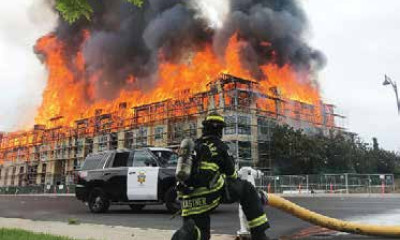A Private Adjuster's Perspective: SPECIAL WILDFIRE EDITION
 Special Wildfire Edition: 2022 California Residential Property Insurance Updates
Special Wildfire Edition: 2022 California Residential Property Insurance Updates
Over the last several years, California has suffered through an unprecedented number of wildfires and other natural and human-caused disasters. Recognizing the impact of these catastrophes on residents’ ability to provide safe and secure housing for themselves and their families, the California Legislature recently made major changes to the State’s Insurance Code. These amendments have been enacted to make it easier for California residents to secure replacement for housing that was lost or damaged in disasters.
At The Greenspan Co./Adjusters International, we always advocate on behalf of policyholders and take seriously our responsibility to educate and inform them. It is in this spirit that we share these important updates and insights that can impact not only your insurance premium but your recovery process as well.
The amendments outlined below relate to losses resulting from a duly declared “state of emergency” (“disaster”).
Time Limit to Collect Full Replacement Cost
Prior Rule: When property was damaged or totally lost due to a disaster, the policyholder was given 24 months from the date of the first actual cash value payment to collect the full replacement cost from their insurance carrier.
Current Rule: The insured will now have 36 months from the date of the first actual cash payment to collect the full replacement cost benefits.
Insights: The updated code gives homeowners a longer grace period after natural disasters, like floods or wildfires, to rebuild their lives and settle back in without being restricted to the 24-month time limit. The updated code recognizes numerous obstacles that are out of the property owner’s control and can cause further delays. Given the typical lack of infrastructure following a wildfire, it is often difficult for a homeowner to replace their property and make a further claim within a short period of time. With the new extension, policyholders will have the flexibility they need to properly rebuild not only their property but their lives overall.
Rebuilding in Current Location or Rebuilding or Replacing in a New Location
Prior Rule: Previously, in order to be compensated for the increased costs of rebuilding or replacing their damaged property according to new building and safety codes, the homeowner was required to rebuild at the specific property address set forth in the insurance policy
Current Rule: Today, the homeowner is allowed to fold all projected costs into the purchase or reconstruction of a new home elsewhere. Thus, the new code gives homeowners greater flexibility in where they may choose to rebuild or relocate after a wildfire and will receive the entirety of their benefits to do so.
Insights: For example, a house was totally destroyed by fire and the insurance company determined the replacement cost of the house at $1 million. In order to adhere to modern safety codes that had been enacted since the original construction of the home, the homeowner would have had to spend an additional $100,000 to rebuild the same house. The additional $100,000 was typically not allocated until the homeowner first spent the $1 million and only if the house was rebuilt at the original location.
Land Value Deduction
Prior Rule: If a homeowner chose to relocate after a fire instead of rebuilding in the same location, the value of the land at the new location would be deducted from the measure of damages.
Current Rule: Today, if the homeowner purchases a house somewhere else, the insurance company is not allowed to deduct the land value from the replacement cost benefits due.
Insights: The updated code allows homeowners to build a house of the same value in a new location, plus retain the value of the land on which their original house stood. The ability to buy elsewhere has always been impacted by the requirement that the value of the land be deducted, leaving homeowners in a precarious position; they are unable to sell a burnt-out lot to create the funds necessary to purchase a new one, potentially leaving them in limbo for years. With this new legislation, the homeowner can now make a choice that will positively affect their family and allow them to restart their lives quickly following a disaster.
Time Limit to Collect Additional Living Expenses (ALE)
Prior Rule: Typically, most insurance policies cover the cost of living elsewhere for only 12 months following a disaster.
Current Rule: The time limit to collect additional living expenses is covered up to 24 months.
Insights: The updated code recognizes that it is difficult to rebuild every property in an affected area within only 12 months and has doubled the existing time limit. In addition, this limit can be extended further to 36 months for good cause.
Uninhabitable/Reasonable Habitation (ALE)
Prior Rule: In an instance where the insured home was still habitable, but the homeowner was unable to return for other reasons, such as hazardous travel or the inability to have water or electricity in the undamaged home, the typical insurance policy covered additional living expenses for a very limited time.
Current Rule: If there is a peril, and a homeowner cannot return or safely remain at their property, payment of additional living expenses is required until it is safe to return.
Insights: Following a fire in the Santa Cruz Mountains, many people were unable to safely return to their homes. Although some of these properties were undamaged, travel was hazardous. In this instance, and in many other cases, the issues took much longer to resolve, and homeowners were not able to return to their property in such a short period of time.
In addition to disaster-specific code changes mentioned above, several special provisions have been introduced.
Itemization of Contents
New, special provisions now mean that if a homeowner, who has experienced a loss relating to a state of emergency, makes a claim for the contents of their primary residence, the insurance company can no longer require them to use a company-specific inventory form, so long as the homeowner can provide an inventory with a form that contains the same information.
Additionally, the insurance company must accept an inventory that includes groupings of categories of personal property such as clothing, shoes, books, food items, CDs, DVDs, or other categories of items, which would be impractical to claim individually.
Insights: Both of these new special provisions, mean that doing inventory following a loss – a long, often emotional process – can be done with much less hassle.
Additional Living Expense (ALE) Advance Payment
Under special provisions, if a homeowner has filed a claim for additional living expenses related to a total loss following a disaster, the insurance company must provide an advance payment of at least four months of living expenses.
Insights: Homeowners can rest assured that they will have the funds necessary to begin rebuilding their lives without worrying about how they will pay for essential living expenses like food and shelter.
Ability to Combine Coverages
In the event of a disaster, such as a wildfire, residential property owners are now allowed to combine payments for losses up to their policy’s limits for their homes and other structures.
Insights: Policyholders whose coverage is insufficient to rebuild or replace the primary home can aggregate policy limits for the dwelling and other structures without requiring actual replacement of the other structures. This offers more protection in the event the primary dwelling is underinsured and helps homeowners reduce what may be required to pay out of pocket.
Cancellation After Total Loss to Primary Structure
Under the new code, an insurance company cannot use the fact that a home is in damaged condition as the sole basis for a decision to cancel a homeowner’s policy, nor can they cancel coverage while a home is being rebuilt after a disaster.
Insights: Homeowners can now remain insured while the home is being rebuilt. This offers flexibility during the post-disaster reconstruction of the home if the home has not been completed by the time the original policy is up for renewal.
Non-Renewal After a Declared Disaster
If a home experiences a total loss caused by a disaster, such as a wildfire, and the losses have not made the property uninsurable, the insurance company is now required to offer the homeowner the option to renew their policy for at least the next two years.
Insights: In the past, many homeowners struggled to renew their insurance following a disaster due to the perceived increased risk to the property by the insurance company. Homeowners can focus on recovering without worrying about whether they will need to find a new insurance carrier.
Insurance language can be complicated, but it is essential for homeowners to understand the new codes that may affect their property should disaster strike. For more resources on decoding insurance policies and language, visit https://www.greenspanai.com/homeowners/resources/. For help with your claim, call the experts at the Greenspan Co./Adjusters International at 800-248-3888.







